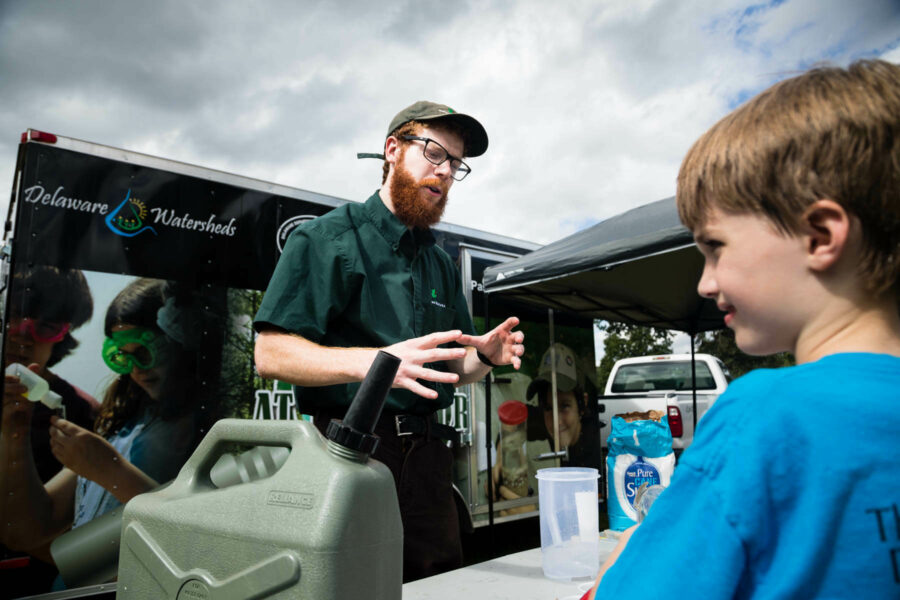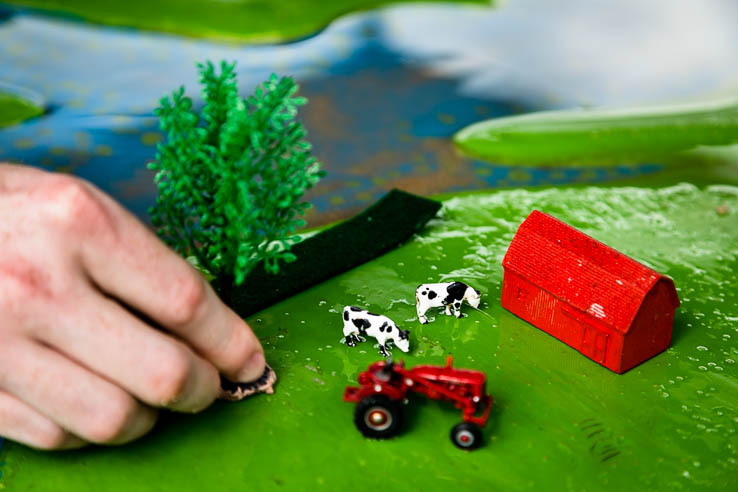The Mobile Science Lab is packed and ready to teach
A Delaware park's traveling trailer increases access to outdoor education

When naturalist Joseph McCarthy needs a stand-in for pollution to use with his tabletop model of Delaware’s Trap Pond State Park, he turns to cocoa powder.
“It basically becomes this cloudy water which is exactly what you want it to look like,” said McCarthy, standing next to a four-foot-long stream that is painted blue and lined by an inch-high farmhouse and tiny green hills.
Materials like sand just sink, while the drink mix gently disperses, creating a chocolatey plume that more clearly resembles real-life nutrient and sediment pollution flowing downstream. Though it makes McCarthy’s hands sticky as he works with young visitors to his table, the cocoa is good at mimicking one source of pollution in particular.
“You say ‘poop’ to kids and they’re interested,” said Connie Hendricks, head of The Jefferson School in Georgetown, where McCarthy recently brought Trap Pond State Park’s Mobile Science Lab to an event called Science Saturday.
The Mobile Science Lab travels inside a large trailer, bringing models, microscopes and monitoring equipment to schools and libraries along with a science-savvy staff. It began last year with a grant from Delaware’s Division of Watershed Stewardship, and it offers a high-tech laboratory experience that also satisfies environmental science teaching standards ranging from third grade to middle school.
 McCarthy places model trees and grass to demonstrate how planting stream buffers can soak up pollution.
McCarthy places model trees and grass to demonstrate how planting stream buffers can soak up pollution.
Environmental education activities like the Mobile Science Lab, sometimes called Meaningful Watershed Education Experiences (MWEEs), have been shown to have a number of benefits to students, including improved academic performance, critical thinking, emotional skills and civic engagement.
Hendricks said the Mobile Science Lab was a good fit for the Jefferson School because of the interactive component—the school already makes regular use of its 43-acre campus, which features two ponds, a garden, a greenhouse and goats. “We’re a small school and we’re very project-based,” Hendricks said.
But not every school has regular access to outdoor amenities.
The Mobile Science Lab is part of Delaware’s Children in Nature Initiative, which began in 2010 in response to a growing understanding that so-called “nature defecit disorder” can lead to negative impacts on children’s health and academic progress.
One of the initiative’s goals is to increase environmental literacy through outdoor experiences and in-school programs. In 2015, for example, Children in Nature won a Bay Watershed Education and Training (B-WET) grant from the National Oceanic and Atmospheric Administration that helped two Delaware school districts install campus gardens and pilot MWEEs.
One advantage of the Mobile Science Lab is that it can immediately reach schools with varying levels of access to the outdoors.
“The program itself can be delivered to anyone from small child to adult,” McCarthy said.
Lessons cover topics such as the physical energy of water, and how to determine water quality by measuring things like nitrates, dissolved oxygen and acidity. At Science Saturday, McCarthy was conducting an “Enviroscape” program that demonstrates the sources of water pollution and practices to prevent it.
“The real goal with this is that it’s so hands on,” McCarthy said. “So they act as the rain and they do the spray bottles. I tell them how to run the experiment but I make them establish their hypotheses. I make them do all of the actual actions involved in the experiments.”
After two girls approached his table at Science Saturday, McCarthy sprinkled a pile of cocoa powder at the water’s edge and let them take aim with the spray bottles. He peppered the visitors with questions about how nutrient pollution leads to algae blooms that choke underwater life, and how Trap Pond is connected to the Chesapeake Bay. He quizzed the girls on erosion.
“With all that in mind, we’re going to clean up our watershed now,” McCarthy said.
He placed tiny trees next to soggy remnants of cocoa, and a thin strip of green fabric to represent grasses.
“That’s going to act like a sponge that’s going to suck up a lot of those nutrients that are going to end up in our water there.”
In another experiment, McCarthy let children try to figure out how to get dissolved sugar, representing pollution, out of a beaker of water. One boy suggested they boil it.
“But over here you’re talking about boiling an entire 90-acre pond,” McCarthy said, gesturing back to his model of Trap Pond.
“Let’s do it!” a boy responded.
McCarthy moved on. He asked the group what could go between the model house and dairy farm to keep pollution from making its way into the water, and this time there was a more reasonable reply among the chorus of tentative answers.
“What about trees?”

Comments
How can we have this experience shared with our students.
Thank you!
Your comment has been received. Before it can be published, the comment will be reviewed by our team to ensure it adheres with our rules of engagement.
Back to recent stories